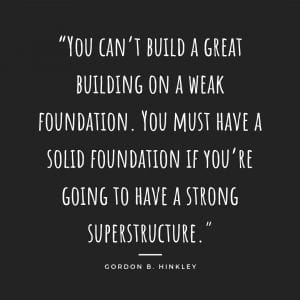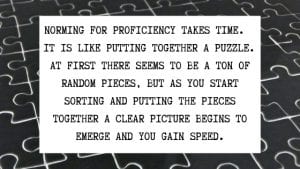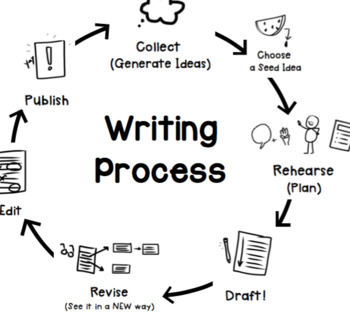
Part 1
There is a certain rush that we as teachers feel as the school year draws near the end. Will we have enough time to get to everything? How do we keep these kids in line? Have we done enough? When does summer begin ☺?
There is also the pressure of looking forward to next year. Are you shifting grade levels? Adopting new curriculum? Jumping into a pilot? Focusing on proficiency based feedback? Or asking how am I going to keep my head above water?
Take a step back. Take a breath….and let’s talk. In order to gain some control and confidence as you move forward, it may benefit you to slow down. Slow down and know that you have support to help you develop a system that allows for a deeper understanding of your standards.
This year I have had the privilege of working with a few teams of teachers to help create a system that allows them to dig deep into their standards and find ways to identify what proficiency means. We have worked together to identify reporting standards and move those into rubrics or proficiency scales that use language and student examples to clarify what proficiency looks like, sounds like, and can be described as. These documents are not created to be kept hidden in our ever growing Google Drive. These are living documents that are evaluated weekly and tweaked to help create clarity amongst a team of individuals that are all teaching students in the same grade span.
When thinking about the best way to write about this process I realized that I did not have the best version of the process to tell. I decided it would be best to reach out to those that have gone through the experience this year and have them share how this process has helped them gain clarity and a solid foundation to move at a quicker pace moving forward.
From the Classroom Teacher’s Perspective
By: Morgan Padalik
When approached with the opportunity of norming in the fall, much like many teachers, my immediate thought was … and when do I have time for this? Up until that point, and even still afterwards, the feeling of not having enough time is always a pressing issue for teachers and there never seems to be enough of it. Being as transparent as possible, the issue of time will always be there, HOWEVER the efficiency and productiveness of time can change and norming has demonstrated that.

As a classroom teacher that specifically focuses on the STEM side of the grade level content, I felt like I had a pretty solid handle of the standards that my kids were being asked to master. Fractions, got it!, Multiplication and Division, you bet! Decimals, piece of cake! As a grade level, we were trying new strategies and structures to meet the individual needs of the kids. Again, as transparent as possible, the new math continuum was a bit overwhelming as it was uncharted territory for not only students but also for us as teachers. Recognizing the nature of the continuum and the proficiency component that is embedded within it, the proposition of norming fell smack dab on our laps at the perfect time.
Fast forward to this spring, we are now fully entrenched in the norming and proficiency process. At this point, we have met as a collective team to create proficiency rubrics for three days and meet weekly to norm our student samples.
We are far more reflective in our marking of students and their progress as we have established consistency and actual parameters of what it means to be proficient. We have edited our completed rubrics again and again and again as we have realized over time how to make them better.
We collect student samples of models of the different proficiency levels and document. Etc…
YES, a lot of time as been put into this adventure however that time has also been invaluable! As a team, our constructive conversations have led to clarity, consistency and a thorough understanding and unpacking of the standards. While the norming process has bitten off a big chunk of our time this year, the transition back into school and math next year will be a lot friendlier based off the work and conversations that we have had this year. We thought we were taking a few steps backward while in reality, we were jumping many steps forward! The time that we have spent has truly been worthwhile as the work produced was lasting work that made a difference not only in student achievement but also teacher performance!
While those in the thick of the proficiency and norming mania can go on and on about the benefits and progress they have experienced and seen, my biggest piece of advice is to JUMP in and start slowly! By no means is anyone expecting you to have it down pat in record time so for that reason, start SLOW! Get into the knack of norming, start to unpack your standards, have meaningful conversations… You have nothing to lose and EVERYTHING to gain. ☺
From RTI’s Perspective

By: Rachael Willson
Believe it or not, math is not as black and white as we all think it is. There are an abundance of resources and activities that address each standard we teach. Unfortunately, not all of these resources and activities are consistent with what the standard actually means. Some go beyond while others just skim the surface of what is truly expected. Just like these inconsistencies in the resources and activities, within our team there were differences in interpretations of what it looked like to be proficient in the standards we were teaching. Even though each one of us knows the standards, the level of expectation differed from classroom to classroom.
This sparked and ignited a discussion with Lauren. Our team decided it was time to meet and create proficiency based rubrics for essential standards within the current domain we were teaching. Yep, another task we added to our plates but in the end so worth it. Our first meeting was an all day affair. We spent pretty much all morning discussing our goals for our meeting and establishing norms. In addition, we examined the standards we were going to identify as “power standards.” Just these two agenda items took time to discuss but they were an integral component for our afternoon task of creating rubrics. The in-depth discussion that took place was valuable, but it was difficult especially if we were not on the same page as far as proficiency. It is important to be open to others’ ideas and opinions. This discussion took a lot of collaboration as well as compromising. Making time to meet, the quick turnaround on providing student samples and using the rubric to norm and then time to discuss the samples we were not on the same page on was a very slow process in the beginning. It takes commitment from all team members involved.
By taking the initiative to begin this process and creating norming rubrics as well as providing student samples to look at and discuss, helped our team align our expectations on proficiency. I am not going to lie and say it was easy at first. Now it is just part of our routine. Norming student work as an individual teacher and comparing our rating with our peers, forced us to step outside of our comfort zone. Flexibility and being open to a living rubric are crucial components to this process. The definition of proficient may change as students display their knowledge. Therefore, there may be a need to tweak the language. In the long run these difficult conversations have brought us closer as a team and the level of collective efficacy has strengthened. We are still working through kinks and tweaking but I feel the time we have put into this process has made us more cognitive of the feedback and activities we provide for our students. Our worthwhile discussions promoted a deeper understanding of the standards as well as what we expect students to know in order to show proficiency. Isn’t this worth the time?

By: Courtney Ward
We were fortunate to be an integral part of the utilizing the math continuum this year. While we started with a proficiency based checklist to monitor student’s achievement, we were finding that it was very cumbersome and pointed out a glaring problem that we weren’t all on the same page when it came to what was proficient. This isn’t to say we didn’t know our standards or what we were supposed to be teaching, just what I thought was mastery level work wasn’t the same as my colleagues, which was surprising because we have taught together for years. There is where the problem lies. We assume we all hold our students to the same level of expectations. Did it mean that one of us is a better teacher than the other? Absolutely not! All it did was provide us an opportunity to become a stronger team of teachers that will do better for students.
We needed a better tool to report; that’s where it all started. How do we create a more useful tool that is less time consuming but would give us a better picture? Rubrics and norming. I would be lying if I said this wasn’t a time consuming process, but I would also be lying if I said this wasn’t the MOST worthwhile PD I have done as an educator. The process wasn’t pretty… we debated… A LOT, we were frustrated, we comprised, but our team left stronger, smarter, and with a clear picture of what proficiency looks like for our students. This led us to weekly norming meetings where we pulled student samples and evaluated each piece using the created rubrics. Initially, the meetings took some time because we again debated on the scores that we all didn’t agree on, but now there are weeks we don’t meet because our scores are all in sync. We have become an well-oiled machine.


















